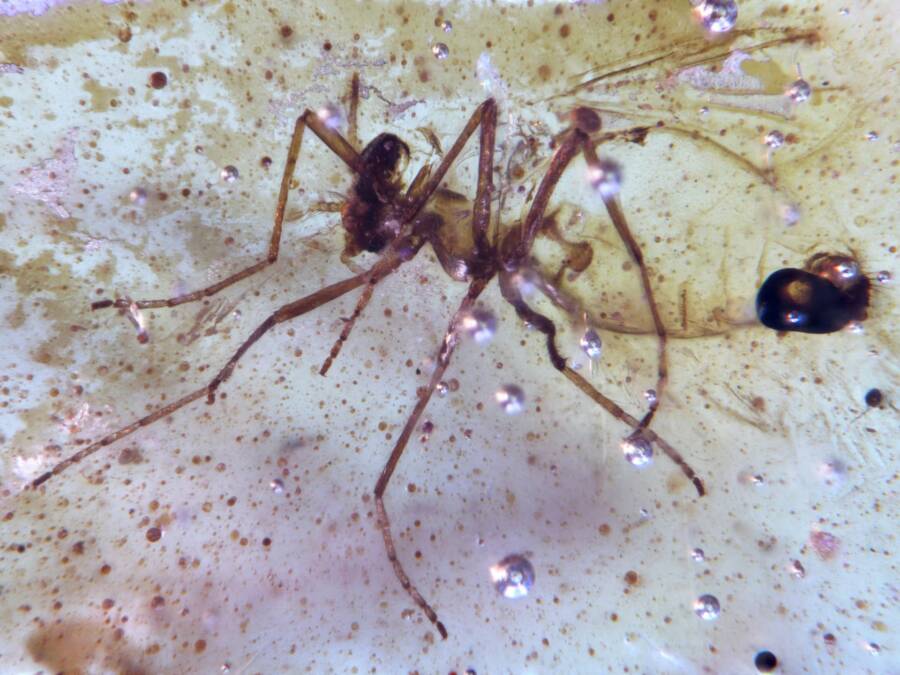Prehistoric Spiderweb, Beetles, And Wasps Perfectly Preserved In Amber Have Been Unearthed In The Amazon
Monica Solorzano-KraemerA 112 million-year-old fly specimen preserved in amber that was unearthed in Ecuador.Scientists have discovered the first insect-bearing amber from the Mesozoic era ever found in South America, offering new insights into this regions humid forest ecosystem that thrived near the equator 112 million years ago.This remarkable discovery from Ecuadors Napo region also represents the largest Mesozoic amber deposit yet found in South America. As described in new research published in Communications Earth & Environment, the find contains exceptionally-preserved arthropods, including flies, beetles, wasps, and fragments of a prehistoric spiderweb.The Discovery Of Prehistoric Insects And A Spiderweb Preserved In Amber For 112 Million YearsThe amber deposits were found at the Genoveva quarry in the Holln Formation, where researchers collected 60 amber samples from petroleum-saturated sandstone. The petroleum has both protected and chemically altered the amber over millions of years.In all, 21 arthropod specimens frozen in amber (known as bioinclusions) from the Cretaceous Period were recovered, representing at least six insect orders. Flies dominate the collection, with 11 specimens including biting midges, chironomids, and long-legged flies. The presence of chironomids and caddisflies both having aquatic larval stages indicates that the areas prehistoric forests had ample bodies of water or generally moist conditions.The amber also preserved parasitic wasps from two families and a beetle belonging to the Tetratomidae family, one rarely found in the fossil record. One particularly significant discovery was a fragment of spiderweb showing seven silk strands arranged in what appears to be an orbicular pattern, though without the sticky droplets typically found on such webs.Monica Solorzano-KraemerA preserved polypore fungus beetle that was found in amber.Chemical analyses using Fourier transform infrared spectroscopy (FTIR) revealed that the amber was produced by araucariacean trees, prehistoric conifers related to modern monkey puzzle trees. The resin formed in two ways: around tree roots and as aerial droplets from trunks and branches. Only the aerial amber contained biological inclusions.Plant fossils found alongside the amber paint a picture of a diverse forest dominated by araucariacean conifers with an understory of ferns and fern allies. The site also preserved the earliest-known angiosperm leaf assemblage from northwestern South America.In all, researchers wrote, This discovery provides direct evidence of a humid, resinous forest ecosystem and its arthropod fauna in equatorial Gondwana during the Cretaceous Resinous Interval.Rare Insight Into How The Ecosystem In Prehistoric Gondwana Changed Over TimeThe forest ecosystem found here contrasts sharply with contemporaneous sites in eastern South America, where arid conditions were prevalent. Global climate models suggest a precipitation gradient existed across the continent during the mid-Cretaceous, with wetter conditions in the west and drier conditions in the east.Notably absent from the Ecuadorian deposits is any evidence of wildfire, a common feature in Cretaceous amber sites in the Northern Hemisphere. This supports the idea that the Ecuadorian site had humid conditions that were unfavorable to fire.Monica Solorzano-KraemerA non-biting midge trapped in amber and preserved for 112 million years.The amber formed during the Cretaceous Resinous Interval, a period between 125 and 72 million years ago that was characterized by extensive resin production by conifers. While such deposits are common in the Northern Hemisphere (several deposits with insects have been found in Myanmar alone just in the last few years, including a millipede, a Venus flytrap wasp, and a hell ant), they are rare in what was once Gondwana the Southern Hemispheres prehistoric supercontinent.Researchers identified the ambers age as early Albian (the last age in the Early Cretaceous) based on pollen assemblages, particularly the co-occurrence of specific species characteristic of that period.Pollen analysis showed that ferns dominated the forest, followed by angiosperms, conifers, and gnetophytes.This discovery and the associated plant remains in the amber-bearing rocks, enhance our understanding of the Gondwanan arthropod fauna and flora inhabiting forests along its western margin during a time interval of major ecosystem transformation, the research team wrote.The specimens will be housed at the Laboratory of Paleontology at Escuela Politcnica Nacional in Quito. The research was conducted by an international team including scientists from Spain, Ecuador, the United States, and Germany.Researchers say future fieldwork in the Holln Formation is expected to yield additional fossil bioinclusions that may further illuminate the evolution and distribution of life in the prehistoric Southern Hemisphere.After reading about this fascinating prehistoric discovery in Ecuador, learn all about the 99-million-year-old insects found in amber in Myanmar on Earth. Then, read about some of the most amazing prehistoric animals that once roamed our planet.The post Prehistoric Spiderweb, Beetles, And Wasps Perfectly Preserved In Amber Have Been Unearthed In The Amazon appeared first on All That's Interesting.


